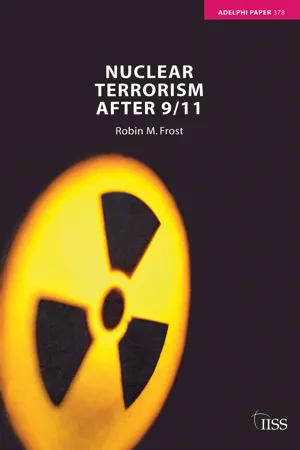
- 144 pages
- English
- ePUB (mobile friendly)
- Available on iOS & Android
Nuclear Terrorism after 9/11
About This Book
The very mention of nuclear terrorism is enough to rouse strong reactions, and understandably so, because it combines the most terrifying weapons and the most threatening of people in a single phrase. The possibility that terrorists could obtain and use nuclear weapons deserves careful analysis, but discussion has all too often been contaminated with exaggeration, even hysteria. For example, it has been claimed that nuclear terrorism poses an 'existential threat' to the United States.
This Adelphi Paper develops a more measured analysis of the risk of terrorists detonating a true fission device. The problem is attacked from two perspectives: the considerable, possibly insurmountable, technical challenges involved in obtaining a functional nuclear weapon, whether 'home-made' or begged, borrowed or stolen from a state arsenal; and the question of the strategic, political and psychological motivations to 'go nuclear'. The conclusions are that nuclear terrorism is a less significant threat than is commonly believed, and that, among terrorists, Muslim extremists are not the most likely to use nuclear weapons.
Frequently asked questions
Information
CHAPTER ONE
The Nuclear Black Market
- Theft or sabotage of nuclear items for demonstration or blackmail
- Environmental contamination - of a city's water supply, for example - with radioactive material.
- Attack on a nuclear reactor or other facility to spread alarm, but with no significant release of radiation.
- Capture of a nuclear reactor for purposes of blackmail.
- Sabotage of a reactor, storage dump or other nuclear facility short of meltdown or a fuel fire.
- A credible, widely publicised nuclear threat that proves to be a hoax (a difficult item to rank, as its effects could in some respects be similar to a genuine attack).
- Detonation of a RDD.
- Damage to a spent fuel storage pool causing a fuel fire.
- Detonation of a low-yield IND.
- Damage to a nuclear reactor including core meltdown, containment breach and large-scale radiation release.
- Detonation of a nuclear weapon from a state arsenal.1

| Date | Location | Material involved | Incident description |
| 24/5/1993 | Vilnius Lithuania | HEU, 1509 | 44 tons of beryllium including 140kg contaminated with HEU were discovered in the storage area of a bank. Beryllium was imported legally. |
| March 1994 | St Petersburg, Russia | HEU, 2.972kg | An individual was arrested In possession of HEU, which he had stolen from a nuclear facility for sale. |
| 10/5/1994 | Tengen-Wiechs, Germany | Pu, 6.2g | The material was detected in a building during a police search. |
| 13/6/1994 | Landshut Germany | HEU, 0.795g | Police arrested a group In illegal possession of HEU. |
| 25/7/1994 | Munich, Germany | Pu, 0.24g | A small sample of PuO2–UO2 mixture was confiscated in an incident related to a larger seizure at Munich airport |
| 10/8/1994 | Munich airport, Germany | Pu, 363.4g | PuO2—UO2 mixture was seized at Munich airport. |
| 14/12/1994 | Prague, Czech Republic | HEU, 2.73kg | HEU was seized by police in Prague. |
| June 1995 | Moscow, Russia | HEU, 1.7kg | An individual was arrested in possession of HEU stolen from a nuclear facility. |
| 6/6/1995 | Prague, Czech Republic | HEU, 0.415g | An HEU sample was seized by police in Prague. |
| 8/6/1995 | Ceske Budejovke, Czech Republic | HEU, 16.9g | An HEU sample was seized by police in Ceske Budejovice. |
| 29/5/1999 | Rousse, Bulgaria | HEU, 10g | Customs officials arrested a man trying to smuggle HEU at the Rousse customs border check point. |
| 2/10/1999 | Kara-Balta, Kyrgyzstan | Pu,1.49g | Two individuals were arrested trying to sell Pu. |
| 19/4/2000 | Batumi, Georgia | HEU, 770g | Four individuals were arrested in possession of HEU |
| 16/9/2000 | Tbilisi airport, Georgia | Pu, 0.4g | Nuclear material including Pu was seized by police at Tbilisi airport. |
| December 2000 | Karlsruhe, Germany | Pu, 0.001g | Mixed radioactive materials including a minute quantity of plutonium were stolen from a former pilot reprocessing plant. |
| 28/1/2001 | Asvestochori, Greece | Pu, ~3g | 245 small metal plates containing Pu were found in a buried cache in the Kourl forest near the village of Asvestochori. |
| 16/7/2001 | Paris, France | HEU, 0.5g | Three individuals trafficking in HEU were arrested in Paris. The perpetrators were seeking buyers for the material |
| 28/01/2001 | Asvestochori, Greece | Pu~3 g | 245 small metal plates containing Pu were found in a buried cache in the Kouri forest near the Asvestochori village. |
| 16/07/2001 | Paris, France | HEU 0.5 g | Three individuals trafficking In HEU were arrested in Pans. The perpetrators were seeking buyers for the material. |
| 26/03/2003 | Sadahlo, Georgia | HEU ~170g | An individual was arrested attempting to illegally transport HEU across the border. |
Table of contents
- Cover
- Title Page
- Copyright Page
- Contents
- Introduction
- Chapter One The Nuclear Black Market
- Chapter Two Improvised Nuclear Devices
- Chapter Three Terrorist Psychology, Motivation and Strategy
- Chapter Four Terrorism and Nuclear Deterrence
- Conclusion
- Appendix Dirty Bombs: Radiological Dispersal and Emission Devices
- Notes